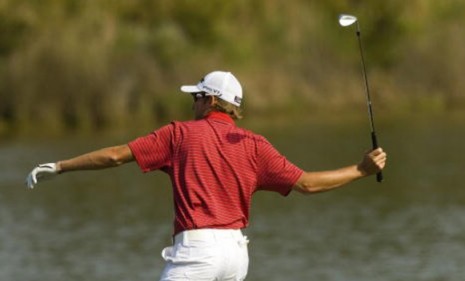The 'miracle' golf ball that won't slice
A new golf ball is specially engineered to fly straight. The only thing wrong with this golfer's dream: It's "completely illegal"

Hitting the ball straight is one of golf's most basic and enduring challenges: Eighty percent of players find their tee shots go astray and end up watching in frustration as their balls repeatedly soar off course. But a small sporting goods company has developed a "miracle" ball engineered not to hook or slice. How can that be? Here, a brief guide:
What's the secret?
The Polara Ultimate Straight "self-correcting" ball looks like a conventional golf ball, but its dimples are set in an irregular pattern. Along its equator, the ball's dimples are shallow, lowering its lift, which means less force can be directed toward pushing a mis-hit ball to the left or right. The truncated dimples also "create a more horizontal spin axis," says The New York Times. This lessens side spin, further discouraging the ball to stray. To reinforce the horizontal spin, the dimples on the poles are deeper.
The Week
Escape your echo chamber. Get the facts behind the news, plus analysis from multiple perspectives.

Sign up for The Week's Free Newsletters
From our morning news briefing to a weekly Good News Newsletter, get the best of The Week delivered directly to your inbox.
From our morning news briefing to a weekly Good News Newsletter, get the best of The Week delivered directly to your inbox.
And this works?
The company says the balls are designed to reduce hooks and slices by 75 percent if positioned on the tee correctly. An independent equipment testing company, Golf Labs, used a golf robot adjusted to intentionally slice its shots, and compared how the Polara Ultimate Straight and conventional balls flew when hit the same way. The regular balls drifted 90 feet to the right, on average. The Polara Ultimate Straight skewed just a few feet from the center line.
That sounds like cheating.
It is. In fact, "it's completely illegal," says Erik Malinowski at Wired. The first version of the Polara went on the market back in 1977, but, in 1981, the United States Golf Association banned it from tournament play because it "reduced the skill required to play golf." A new "symmetry rule" required balls to perform the same no matter how they were placed on the tee. In 1984, the USGA agreed to pay Polaris a $1.4 million settlement to remove the ball from the market. But a company called Aero-X Golf Inc. acquired the Polara technology in 2005, tweaked it, and started selling the balls again last year.
A free daily email with the biggest news stories of the day – and the best features from TheWeek.com
So this is a ball for lousy golfers?
Yes, Aero-X Golf is under no illusions that the Polara will appeal to elite golfers. "It's for the other golfers, the ones who rarely hit straight," Aero-X Golf's Dave Felker told The New York Times. And even in casual play they'll have to bend the rules to use it. After each shot, if the ball doesn't miraculously land with the stamped arrow pointing where the ball needs to head next, the golfer has to touch it and rotate it, violating a basic rule of the game. "It wouldn’t matter one bit to me," beginning golfer Fredric Martenson, 36, told the Times. "I just want to go out and not spend the whole day looking for my ball."
Sources: NY Times, Wired, Golf Club Business, Polara Golf
-
 Political cartoons for December 13
Political cartoons for December 13Cartoons Saturday's political cartoons include saving healthcare, the affordability crisis, and more
-
 Farage’s £9m windfall: will it smooth his path to power?
Farage’s £9m windfall: will it smooth his path to power?In Depth The record donation has come amidst rumours of collaboration with the Conservatives and allegations of racism in Farage's school days
-
 The issue dividing Israel: ultra-Orthodox draft dodgers
The issue dividing Israel: ultra-Orthodox draft dodgersIn the Spotlight A new bill has solidified the community’s ‘draft evasion’ stance, with this issue becoming the country’s ‘greatest internal security threat’